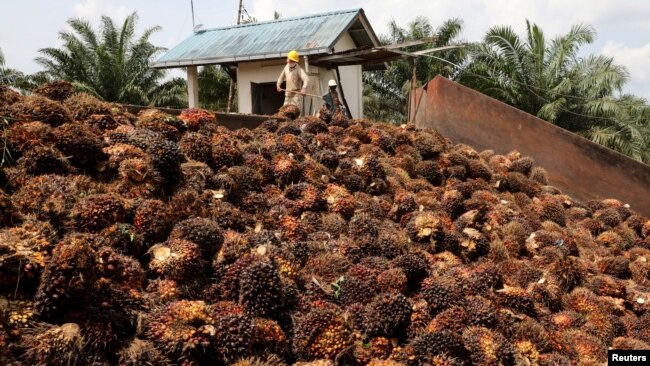パーム油、供給網の行方
IndonesiaとMalaysian


知り合いにも、インドネシアにおけるパーム油の国内外への安定供給に貢献したいと会社を設立した人がいます。政府と中国資本も絡み、中々進まないようですが。
VOAで今日も英語を学びましょう!!
インドネシアの政策により、マレーシアがパーム油輸出で優位に立つ(和訳)
Indonesia's Policy Gives Malaysia Edge in Palm Oil Export
May 18,2022
インドネシアは世界最大のパーム油生産国です。しかし、その”予測不可能な”輸出政策によって、マレーシアが世界一の買い手であるインドへの主要供給国になる可能性があります。
パーム油は、熱帯地方でしか育たないヤシの木から採れます。パーム油は、発展途上国では主に調理に使われています。また、食品や美容、洗浄剤などにも使用されています。
先月、インドネシアはパーム油の他国への販売禁止を発表しました。ジョコ・ウィドド大統領は4月27日の声明で、現地の需要が満たされ、価格が下がれば禁止令を解除すると述べました。
マレーシアは世界第2位のパーム油生産国で、生産量はインドネシアの半分以下です。インドネシアが禁止令を発表した直後、マレーシアは輸出税を半減させ、パーム油の主要供給国になることを位置づけました。
業界団体のSolvent Extractors' Association of Indiaは、この2つの出来事により、2022年10月にはインドへのパーム油輸出におけるインドネシアのシェアが35%に低下する可能性があると試算します。10年前、インドネシアのシェアは75%以上でした。
B.V. メータ氏はムンバイに本拠を置く協会の理事です。彼は、「インドネシアが市場に出てこないので、マレーシアがより多く、しかも記録的な高値に近い値段で売っている 。」と述べています。
協会の報告によると、2021年の最後の数ヶ月と今年の最初の4ヶ月の間に、インドはマレーシアから147万トンのパーム油を購入したとのことです。そして、インドはインドネシアから100万トンのパーム油を買ってさえいません。5月については、インドはマレーシアからより多くのパーム油を購入し続けており、禁止令がこのままであれば、インドネシアからの輸入はさらに減少すると予想しています。
最近の増加にもかかわらず、マレーシアの生産者はインドネシアからのパーム油の供給者に完全に取って代わることはできていません。マレーシアはインドネシアの40%しか生産しておらず、労働者不足に直面しています。しかし、インドのバイヤーは依然としてマレーシアと取引し、インドネシアからのパーム油への依存を減らしたいと考えています。
名前を伏せたインドのバイヤーは、「インドネシアは今月中に輸出禁止を解除するかもしれないが、再び輸出を制限しない保証はありません。マレーシアの輸出政策の方がはるかに安定しており、我々が望んでいるのはそれなんです。」 と言っています。
Indonesia's Policy Gives Malaysia Edge in Palm Oil Export
Indonesia is the world’s biggest palm oil producer. But its “unpredictable” export policies may help Malaysia become the main supplier to India, the world’s top buyer of the product.
The oil comes from a palm tree that is only grown in the tropics. Palm oil is used primarily for cooking in developing countries. It is also used in food, beauty, and cleaning products.
Last month, Indonesia announced a ban on the sales of palm oil to other countries. President Joko Widodo said in a statement on April 27 that the ban would be lifted once local demand was met and prices lowered.
Malaysia is the world’s second-largest palm oil producer with less than half of Indonesia’s output. Shortly after Indonesia announced its ban, Malaysia positioned itself to become a major supplier of palm oil by cutting the export tax by half.
The trade group Solvent Extractors' Association of India estimates that the two events could lower Indonesia’s share of the palm oil exports to India to 35 percent by October of 2022. Ten years ago, Indonesia’s market share was over 75 percent.
B.V. Mehta is a director of the Mumbai-based association. He said, “As Indonesia is not in the market, Malaysia is selling more, and at near record high prices."
The association reports that during the last months of 2021 and first 4 months of this year, India bought 1.47 million tons of palm oil from Malaysia. And India has not even bought a million tons of palm oil from Indonesia. For the month of May, India continues to buy more palm oil from Malaysia and the country expects imports from Indonesia to fall further if the ban stays in place.
Despite the recent increase, Malaysian producers cannot totally replace palm oil suppliers from Indonesia. The country only produces 40 percent of what Indonesia does and it is facing a shortage of workers. Indian buyers, however, still want to deal with Malaysia and reduce its dependence on palm oil from Indonesia.
An Indian buyer who did not want to be named said, “Indonesia may lift the ban on exports sometime this month, but there is no guarantee it will not restrict exports again. Malaysia's export policy is far more stable and that's what we want.”
Words in This Story
tropics – n. (pl.) parts of the world that are near the equator and, therefore, are usually warm
stable — adj. in a good state or condition that is not easily changed or likely to change
